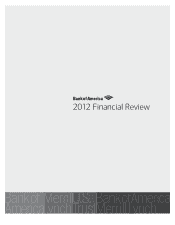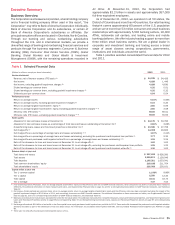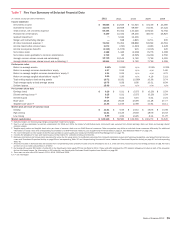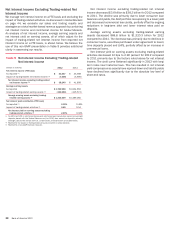Bank of America 2012 Annual Report Download - page 24
Download and view the complete annual report
Please find page 24 of the 2012 Bank of America annual report below. You can navigate through the pages in the report by either clicking on the pages listed below, or by using the keyword search tool below to find specific information within the annual report.22 Bank of America 2012
2012 Economic and Business Environment
The U.S. economy began 2012 with momentum in consumer
spending, led by stronger vehicle sales and supported by larger
private payroll gains. However, over the course of the year,
consumer spending slowed and business spending continued to
weaken following the expiration of 2011 tax incentives and ongoing
uncertainties surrounding fiscal issues in the U.S. and Europe.
Payroll gains steadied to a moderate pace, while business profits
and cash flows continued to rise throughout the year. The
unemployment rate ended the year at 7.8 percent. Equity markets
were volatile but finished with appreciable gains in 2012. The
housing sector improved as new and existing home sales rose,
home prices increased and residential building activity ended the
year with its seventh consecutive quarterly rise.
After briefly rising early in the year, bond yields fell as the U.S.
economy slowed and economic uncertainties in Europe intensified.
The low bond yields also reflected the Board of Governors of the
Federal Reserve System’s (Federal Reserve) monetary easing and
related efforts to keep bond yields low. In December 2012, the
Federal Reserve announced that it would purchase an additional
$45 billion per month of long-term U.S. Treasury securities, in
addition to its $40 billion per month in mortgage-backed securities
(MBS) purchases, and that any policy rate increase would be tied
to a 6.5 percent unemployment rate target as long as inflation did
not exceed 2.5 percent.
Europe experienced financial market turmoil, numerous policy
interventions and spreading recession in 2012. The European
Central Bank’s (ECB) long-term refinancing operations helped calm
markets for a time but proved insufficient as emerging stresses
generated renewed turmoil. In response to sharply rising sovereign
bond yields, the ECB announced its willingness to intervene in
sovereign debt markets under specified conditions which calmed
markets and pushed down sovereign bond yields. Near year end,
the benefits of structural reform, such as lower labor costs and
smaller structural budget deficits, were becoming evident in select
nations while sovereign spreads stabilized at lower levels.
However, widespread recession persisted.
Although the Asian economy continued to expand in 2012,
several key nations slowed during the year. China’s economic
growth remained subdued in 2012, adversely impacting
international trade and overall Asian economic performance.
Japan’s economy expanded in the first half of the year but returned
to recession in the second half of the year.
Recent Events
Fannie Mae Settlement
On January 6, 2013, we entered into an agreement with Fannie
Mae (FNMA) to resolve substantially all outstanding and potential
repurchase and certain other claims relating to the origination,
sale and delivery of residential mortgage loans originated and sold
directly to FNMA from January 1, 2000 through December 31,
2008 by entities related to legacy Countrywide Financial
Corporation (Countrywide) and Bank of America, N.A. (BANA).
This agreement covers loans with an aggregate original principal
balance of approximately $1.4 trillion. Unresolved repurchase
claims submitted by FNMA for alleged breaches of selling
representations and warranties with respect to these loans totaled
$12.2 billion at December 31, 2012. This agreement extinguished
substantially all of those unresolved repurchase claims, as well
as substantially all future representations and warranties
repurchase claims associated with the loans, subject to certain
exceptions which we do not expect to be material.
In January 2013, we made a cash payment to FNMA of $3.6
billion and also repurchased for $6.6 billion certain residential
mortgage loans that had previously been sold to FNMA, which we
have valued at less than the purchase price.
This agreement also clarified the parties’ obligations with
respect to mortgage insurance, including establishing timeframes
for certain payments and other actions, setting parameters for
potential bulk settlements and providing for cooperation in future
dealings with mortgage insurers.
In addition, pursuant to a separate agreement, we settled
substantially all of FNMA’s outstanding and future claims for
compensatory fees arising out of past foreclosure delays.
Collectively, these agreements are the FNMA Settlement. For
additional information, see Off-Balance Sheet Arrangements and
Contractual Obligations – Representations and Warranties on page
50 and Note 8 – Representations and Warranties Obligations and
Corporate Guarantees to the Consolidated Financial Statements.
Independent Foreclosure Review Acceleration
Agreement
On January 7, 2013, Bank of America and other mortgage servicing
institutions entered into an agreement with the Office of the
Comptroller of the Currency (OCC) and the Federal Reserve to
cease the Independent Foreclosure Review (IFR) that had
commenced pursuant to a consent order entered into by Bank of
America with the Federal Reserve and by BANA with the OCC on
April 13, 2011 (2011 OCC Consent Order) and replace it with an
accelerated remediation process (2013 IFR Acceleration
Agreement). Under the 2013 IFR Acceleration Agreement, the
mortgage servicing institutions agreed to make aggregate cash
payments totaling $3.8 billion and provide $6.0 billion of other
assistance to help borrowers, such as loan modifications and
forgiveness of deficiency judgments. The 2013 IFR Acceleration
Agreement requires us to make a cash payment of $1.1 billion
and provide $1.8 billion of borrower assistance in the form of loan
modifications and other foreclosure prevention actions. For
additional information, see Off-Balance Sheet Arrangements and
Contractual Obligations – Other Mortgage-related Matters on page
57.
Sales of Mortgage Servicing Rights
On January 6, 2013, Bank of America entered into definitive
agreements with two different counterparties, and on February 19,
2013 with an additional counterparty to sell the servicing rights
on certain residential mortgage loans serviced for FNMA, Freddie
Mac (FHLMC), the Government National Mortgage Association
(GNMA) and private-label securitizations, with an aggregate unpaid
principal balance of approximately $317 billion. The sales involve
approximately 2.1 million loans currently serviced by us, including
approximately 234,000 residential mortgage loans and
approximately 24,000 home equity loans that were 60 days or
more past due at December 31, 2012.
The transfers of servicing rights are scheduled to occur in
stages throughout 2013 and are subject to the approval or consent
of certain third parties. There is no assurance that all the required
approvals and consents will be obtained, and accordingly, some
of these transfers may not be consummated. We may conduct
additional sales of mortgage servicing rights (MSRs) in the future.
























